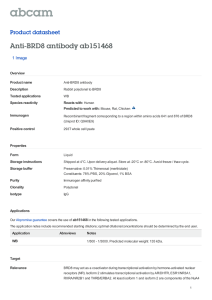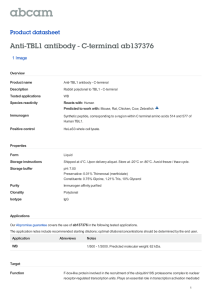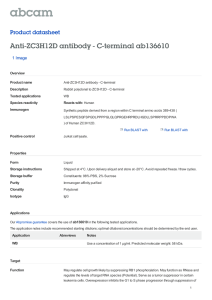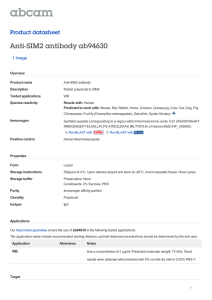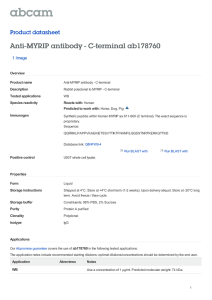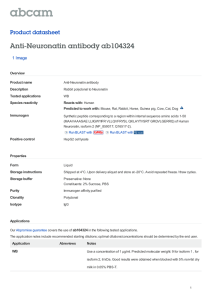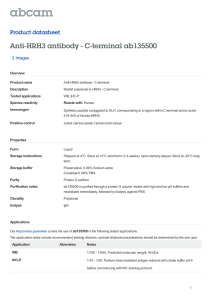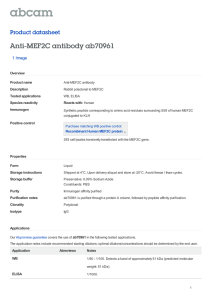Anti-MEF2C antibody - C-terminal ab191092 Product datasheet 2 Images
advertisement
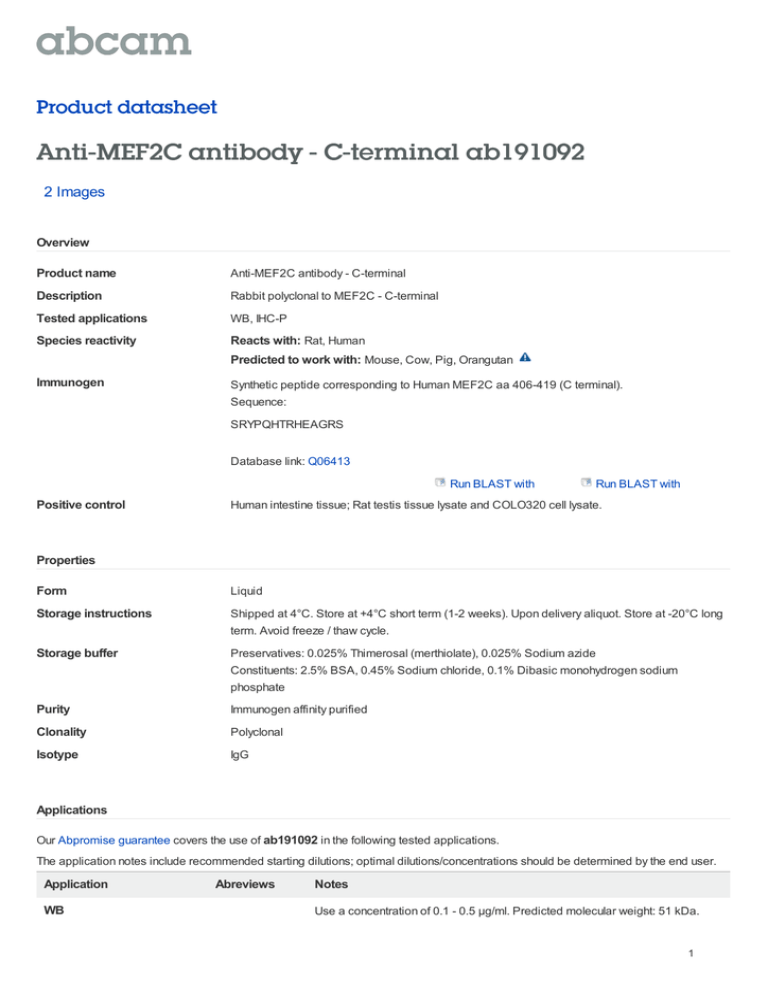
Product datasheet Anti-MEF2C antibody - C-terminal ab191092 2 Images Overview Product name Anti-MEF2C antibody - C-terminal Description Rabbit polyclonal to MEF2C - C-terminal Tested applications WB, IHC-P Species reactivity Reacts with: Rat, Human Predicted to work with: Mouse, Cow, Pig, Orangutan Immunogen Synthetic peptide corresponding to Human MEF2C aa 406-419 (C terminal). Sequence: SRYPQHTRHEAGRS Database link: Q06413 Run BLAST with Positive control Run BLAST with Human intestine tissue; Rat testis tissue lysate and COLO320 cell lysate. Properties Form Liquid Storage instructions Shipped at 4°C. Store at +4°C short term (1-2 weeks). Upon delivery aliquot. Store at -20°C long term. Avoid freeze / thaw cycle. Storage buffer Preservatives: 0.025% Thimerosal (merthiolate), 0.025% Sodium azide Constituents: 2.5% BSA, 0.45% Sodium chloride, 0.1% Dibasic monohydrogen sodium phosphate Purity Immunogen affinity purified Clonality Polyclonal Isotype IgG Applications Our Abpromise guarantee covers the use of ab191092 in the following tested applications. The application notes include recommended starting dilutions; optimal dilutions/concentrations should be determined by the end user. Application WB Abreviews Notes Use a concentration of 0.1 - 0.5 µg/ml. Predicted molecular weight: 51 kDa. 1 Application Abreviews IHC-P Notes Use a concentration of 0.5 - 1 µg/ml. Perform heat mediated antigen retrieval with citrate buffer pH 6 before commencing with IHC staining protocol. Target Function Transcription activator which binds specifically to the MEF2 element present in the regulatory regions of many muscle-specific genes. Controls cardiac morphogenesis and myogenesis, and is also involved in vascular development. Plays an essential role in hippocampal-dependent learning and memory by suppressing the number of excitatory synapses and thus regulating basal and evoked synaptic transmission. Crucial for normal neuronal development, distribution, and electrical activity in the neocortex. Necessary for proper development of megakaryocytes and platelets and for bone marrow B lymphopoiesis. Required for B-cell survival and proliferation in response to BCR stimulation, efficient IgG1 antibody responses to T-cell-dependent antigens and for normal induction of germinal center B cells. May also be involved in neurogenesis and in the development of cortical architecture (By similarity). Isoform 3 and isoform 4, which lack the repressor domain, are more active than isoform 1 and isoform 2. Tissue specificity Expressed in brain and skeletal muscle. Involvement in disease Defects in MEF2C are the cause of mental retardation-stereotypic movements-epilepsy and/or cerebral malformations (MRSME) [MIM:613443]. It is a disorder characterized by severe mental retardation, absent speech, hypotonia, poor eye contact and stereotypic movements. Dysmorphic features include high broad forehead with variable small chin, short nose with anteverted nares, large open mouth, upslanted palpebral fissures and prominent eyebrows. Some patients have seizures. Sequence similarities Belongs to the MEF2 family. Contains 1 MADS-box domain. Contains 1 Mef2-type DNA-binding domain. Developmental stage Expression is highest during the early stages of postnatal development, at later stages levels greatly decrease. Domain The beta domain, missing in a number of isoforms, is required for enhancement of transcriptional activity. Post-translational modifications Phosphorylation on Ser-59 enhances DNA binding activity (By similarity). Phosphorylation on Ser-396 is required for Lys-391 sumoylation and inhibits transcriptional activity. Acetylated by p300 on several sites in diffentiating myocytes. Acetylation on Lys-4 increases DNA binding and transactivation. Sumoylated on Lys-391 by SUMO2 but not by SUMO1 represses transcriptional activity. Proteolytically cleaved in cerebellar granule neurons, probably by caspase 7, following neurotoxicity. Preferentially cleaves the CDK5-mediated hyperphosphorylated form which leads to neuron apoptosis and transcriptional inactivation. Cellular localization Nucleus. Anti-MEF2C antibody - C-terminal images 2 All lanes : Anti-MEF2C antibody - C-terminal (ab191092) at 0.5 µg/ml Lane 1 : Rat testis tissue lysate Lane 2 : COLO320 cell lysate Predicted band size : 51 kDa Western blot - Anti-MEF2C antibody (ab191092) Immunohistochemical analysis of paraffinembedded Human intestine tissue labeling MEF2C with ab191092 at 1 µg/ml. Immunohistochemistry (Formalin/PFA-fixed paraffin-embedded sections) - Anti-MEF2C antibody (ab191092) Please note: All products are "FOR RESEARCH USE ONLY AND ARE NOT INTENDED FOR DIAGNOSTIC OR THERAPEUTIC USE" Our Abpromise to you: Quality guaranteed and expert technical support Replacement or refund for products not performing as stated on the datasheet Valid for 12 months from date of delivery Response to your inquiry within 24 hours We provide support in Chinese, English, French, German, Japanese and Spanish Extensive multi-media technical resources to help you We investigate all quality concerns to ensure our products perform to the highest standards If the product does not perform as described on this datasheet, we will offer a refund or replacement. For full details of the Abpromise, please visit http://www.abcam.com/abpromise or contact our technical team. Terms and conditions Guarantee only valid for products bought direct from Abcam or one of our authorized distributors 3
